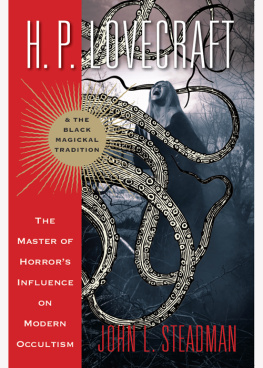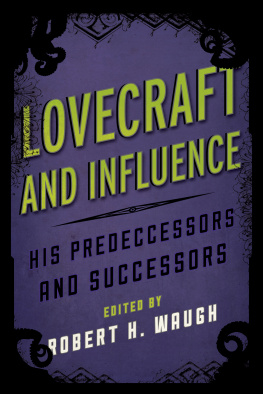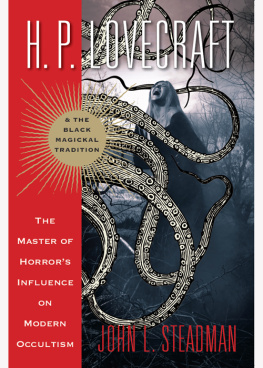Howard Lovecraft - Out of the Aeons
Here you can read online Howard Lovecraft - Out of the Aeons full text of the book (entire story) in english for free. Download pdf and epub, get meaning, cover and reviews about this ebook. genre: Science fiction. Description of the work, (preface) as well as reviews are available. Best literature library LitArk.com created for fans of good reading and offers a wide selection of genres:
Romance novel
Science fiction
Adventure
Detective
Science
History
Home and family
Prose
Art
Politics
Computer
Non-fiction
Religion
Business
Children
Humor
Choose a favorite category and find really read worthwhile books. Enjoy immersion in the world of imagination, feel the emotions of the characters or learn something new for yourself, make an fascinating discovery.

- Book:Out of the Aeons
- Author:
- Genre:
- Rating:4 / 5
- Favourites:Add to favourites
- Your mark:
- 80
- 1
- 2
- 3
- 4
- 5
Out of the Aeons: summary, description and annotation
We offer to read an annotation, description, summary or preface (depends on what the author of the book "Out of the Aeons" wrote himself). If you haven't found the necessary information about the book — write in the comments, we will try to find it.
Out of the Aeons — read online for free the complete book (whole text) full work
Below is the text of the book, divided by pages. System saving the place of the last page read, allows you to conveniently read the book "Out of the Aeons" online for free, without having to search again every time where you left off. Put a bookmark, and you can go to the page where you finished reading at any time.
Font size:
Interval:
Bookmark:
Out of the Aeons
by Howard Philips Lovecraft
I
It is not likely that anyone in Boston or any alert reader elsewhere will ever forget the strange affair of the Cabot Museum . The newspaper publicity given to that hellish mummy, the antique and terrible rumours vaguely linked with it, the morbid wave of interest and cult activities during 1932, and the frightful fate of the two intruders on December 1st of that year, all combined to form one of those classic mysteries which go down for generations as folklore and become the nuclei of whole cycles of horrific speculation.
Everyone seems to realise, too, that something very vital and unutterably hideous was suppressed in the public accounts of the culminant horrors. Those first disquieting hints as to the condition of one of the two bodies were dismissed and ignored too abruptly nor were the singular modifications in the mummy given the following-up which their news value would normally prompt. It also struck people as queer that the mummy was never restored to its case. In these days of expert taxidermy the excuse that its disintegrating condition made exhibition impracticable seemed a peculiarly lame one.
As curator of the museum I am in a position to reveal all the suppressed facts, but this I shall not do during my lifetime. There are things about the world and universe which it is better for the majority not to know, and I have not departed from the opinion in which all of us museum staff, physicians, reporters, and police concurred at the period of the horror itself. At the same time it seems proper that a matter of such overwhelming scientific and historic importance should not remain wholly unrecorded hence this account which I have prepared for the benefit of serious students. I shall place it among various papers to be examined after my death, leaving its fate to the discretion of my executors. Certain threats and unusual events during the past weeks have led me to believe that my life as well as that of other museum officials is in some peril through the enmity of several widespread secret cults of Asiatics, Polynesians, and heterogeneous mystical devotees; hence it is possible that the work of the executors may not be long postponed. [Executor's note: Dr. Johnson died suddenly and rather mysteriously of heart-failure on April 22, 1933. Wentworth Moore, taxidermist of the museum, disappeared around the middle of the preceding month. On February 18 of the same year Dr. William Minot, who superintended a dissection connected with the case, was stabbed in the back, dying the following day.]
The real beginning of the horror, I suppose, was in 1879 long before my term as curator when the museum acquired that ghastly, inexplicable mummy from the Orient Shipping Company. Its very discovery was monstrous and menacing, for it came from a crypt of unknown origin and fabulous antiquity on a bit of land suddenly upheaved from the Pacific's floor.
On May 11, 1878, Capt. Charles Weatherbee of the freighter Eridanus, bound from Wellington , New Zealand , to Valparaiso , Chile , had sighted a new island unmarked on any chart and evidently of volcanic origin. It projected quite boldly out of the sea in the form of a truncated cone. A landing-party under Capt. Weatherbee noted evidences of long submersion on the rugged slopes which they climbed, while at the summit there were signs of recent destruction, as by an earthquake. Among the scattered rubble were massive stones of manifestly artificial shaping, and a little examination disclosed the presence of some of that prehistoric Cyclopean masonry found on certain Pacific islands and forming a perpetual archaeological puzzle.
Finally the sailors entered a massive stone crypt judged to have been part of a much larger edifice, and to have originally lain far underground in one corner of which the frightful mummy crouched. After a short period of virtual panic, caused partly by certain carvings on the walls, the men were induced to move the mummy to the ship, though it was only with fear and loathing that they touched it. Close to the body, as if once thrust into its clothes, was a cylinder of an unknown metal containing a roll of thin, bluishwhite membrane of equally unknown nature, inscribed with peculiar characters in a greyish, indeterminable pigment. In the centre of the vast stone floor was a suggestion of a trap-door, but the party lacked apparatus sufficiently powerful to move it.
The Cabot Museum , then newly established, saw the meagre reports of the discovery and at once took steps to acquire the mummy and the cylinder. Curator Pickman made a personal trip to Valparaiso and outfitted a schooner to search for the crypt where the thing had been found, though meeting with failure in this matter. At the recorded position of the island nothing but the sea's unbroken expanse could be discerned, and the seekers realised that the same seismic forces which had suddenly thrust the island up had carried it down again to the watery darkness where it had brooded for untold aeons. The secret of that immovable trap-door would never be solved. The mummy and the cylinder, however, remained and the former was placed on exhibition early in November, 1879, in the museum's hall of mummies.
The Cabot Museum of Archaeology, which specialises in such remnants of ancient and unknown civilisations as do not fall within the domain of art, is a small and scarcely famous institution, though one of high standing in scientific circles. It stands in the heart of Boston 's exclusive Beacon Hill district in Mt. Vernon Street , near Joy housed in a former private mansion with an added wing in the rear, and was a source of pride to its austere neighbours until the recent terrible events brought it an undesirable notoriety. The hall of mummies on the western side of the original mansion (which was designed by Bulfinch and erected in 1819), on the second floor, is justly esteemed by historians and anthropologists as harbouring the greatest collection of its kind in America . Here may be found typical examples of Egyptian embalming from the earliest Sakkarah specimens to the last Coptic attempts of the eighth century; mummies of other cultures, including the prehistoric Indian specimens recently found in the Aleutian Islands; agonised Pompeian figures moulded in plaster from tragic hollows in the ruin choking ashes; naturally mummified bodies from mines and other excavations in all parts of the earth some surprised by their terrible entombment in the grotesque postures caused by their last, tearing death-throes everything, in short, which any collection of the sort could well be expected to contain. In 1879, of course, it was much less ample than it is now; yet even then it was remarkable. But that shocking thing from the primal Cyclopean crypt on an ephemeral sea-spawned island was always its chief attraction and most impenetrable mystery.
The mummy was that of a medium-sized man of unknown race, and was cast in a peculiar crouching posture. The face, half shielded by claw-like hands, had its under jaw thrust far forward, while the shrivelled features bore an expression of fright so hideous that few spectators could view them unmoved. The eyes were closed, with lids clamped down tightly over eyeballs apparently bulging and prominent. Bits of hair and beard remained, and the colour of the whole was a sort of dull neutral grey. In texture the thing was half leathery and half stony, forming an insoluble enigma to those experts who sought to ascertain how it was embalmed. In places bits of its substance were eaten away by time and decay. Rags of some peculiar fabric, with suggestions of unknown designs, still clung to the object.
Just what made it so infinitely horrible and repulsive one could hardly say. For one thing, there was a subtle, indefinable sense of limitless antiquity and utter alienage which affected one like a view from the brink of a monstrous abyss of unplumbed blackness but mostly it was the expression of crazed fear on the puckered, prognathous, half-shielded face. Such a symbol of infinite, inhuman, cosmic fright could not help communicating the emotion to the beholder amidst a disquieting cloud of mystery and vain conjecture.
Font size:
Interval:
Bookmark:
Similar books «Out of the Aeons»
Look at similar books to Out of the Aeons. We have selected literature similar in name and meaning in the hope of providing readers with more options to find new, interesting, not yet read works.
Discussion, reviews of the book Out of the Aeons and just readers' own opinions. Leave your comments, write what you think about the work, its meaning or the main characters. Specify what exactly you liked and what you didn't like, and why you think so.



